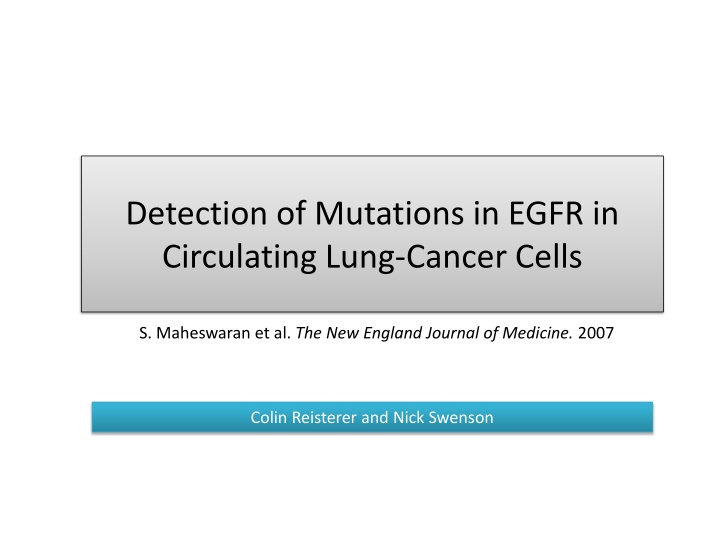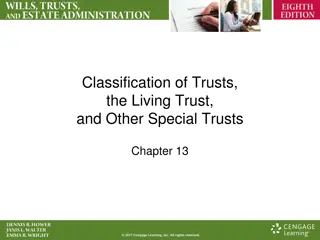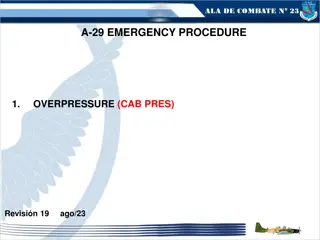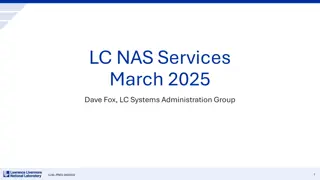
EGFR Mutations in NSCLC Circulating Cells: Detection & Treatment Insights
Explore the detection of EGFR mutations in circulating lung cancer cells, the clinical background of NSCLC, treatment options including Tyrosine Kinase Inhibitors (TKIs), and the importance of monitoring mutations in circulating tumor cells. Learn about the challenges and advancements in managing NSCLC effectively.
Download Presentation

Please find below an Image/Link to download the presentation.
The content on the website is provided AS IS for your information and personal use only. It may not be sold, licensed, or shared on other websites without obtaining consent from the author. If you encounter any issues during the download, it is possible that the publisher has removed the file from their server.
You are allowed to download the files provided on this website for personal or commercial use, subject to the condition that they are used lawfully. All files are the property of their respective owners.
The content on the website is provided AS IS for your information and personal use only. It may not be sold, licensed, or shared on other websites without obtaining consent from the author.
E N D
Presentation Transcript
Detection of Mutations in EGFR in Circulating Lung-Cancer Cells S. Maheswaran et al. The New England Journal of Medicine. 2007 Colin Reisterer and Nick Swenson
Clinical background: Non-small cell lung cancer (NSCLC) NSCLC is the most common form of lung cancer and is primarily caused by smoking and other inhalable carcinogens. Morbidity is high and treatment is difficult. Stages of NSCLC I. Tumor is limited to the lung in normal tissue Tumor spreads to area around lung Tumor spreads to lymph nodes, other side of chest, and/or neck Tumor spreads elsewhere in lungs & metastasises in other areas of the body II. http://www.all-cancer-treatments.com/types-of-lung-cancer.html Outlook 14% 5+ year survival Stage 1 NSCLC: surgical intervention has 70% 5+ year survival Nonoperable NSCLC: 9 month average survival after diagnosis III. IV. (2011). Non-Small-Cell Lung Cancer. http://www.webmd.com/lung-cancer/no-small-cell-lung-cancer
Treatment options for NSCLC Surgery Chemotherapy DNA damaging drugs Cell growth inhibitors Tyrosine Kinase Inhibitors Excision of the lung tumor mass Most effective solution but only applicable in early stages (33% operable) 50% relapse rate Radiation & Laser Therapy Concentrated energy to destroy tumor cells Gefitinib (Iressa) Erlotinib (Tarceva) Surgery is most effective treatment, but most patients will require an alternative due to late stage tumor progression!
Tyrosine Kinase Inhibitors (TKIs) The Tyrosine Kinase Inhibitors used to treat NSCLC target EGFR which is mutated and oncogenic in many lung cancers. Treatments are effective but relapses are commonly experienced. TKI Target: Epithelial Growth Factor Receptor (EGFR), a Proto-Oncogene EGFR Receptors EGFR controls DNA synthesis and cell proliferation Cancerous mutations in EGFR upregulate signaling and can be blocked by tyrosine kinase inhibitors Tyrosine kinases (drug target) Problem: Most patients using TKIs see relapse within 1 year DNA synthesis, cell proliferation, tumor growth
Monitoring mutations in circulating tumor cells NSCLC tumor cells acquire additional EGFR mutations that inhibit drug action. Patients taking TKIs need to be monitored to determine if alternate therapy must be pursued. Capture of circulating tumor cells using CTC-Chip Technology Authors previously developed microfluidic device to isolate circulating tumor cells Blood samples are flowed through the chip and tumor cells are captured by posts coated in antibody specific to epithelial tumor cells Bound tumor cells can be analyzed for EGFR mutations that confer resistance to TKIs Nagrath, S., L. V. Sequist, et al. (2007). "Isolation of rare circulating tumour cells in cancer patients by microchip technology." Nature 450(7173): 1235-1239. CTC-Chip capture is robust, high purity, minimally invasive method for collection of circulating tumor cells in patients!
Analysis of DNA mutations in captured tumor cells The CTC-Chip was used to capture tumor cells from the blood of 23 different patients. To test for EGFR mutations the SARMS assay was validated and utilized. 1. DNA extraction from captured tumor cells 2. Scorpion Amplification Refractory Mutation System (SARMS) SARMS assay allows for detection of multiple EGFR mutations using DNA-fluorophore hybrids complementary to mutated alleles in question Authors validated assay by re-identifying mutations in samples with previously known mutations Whitcombe, D., J. Theaker, et al. (1999). "Detection of PCR products using self- probing amplicons and fluorescence." Nat Biotechnol 17(8): 804-807. Found the SARMS test could identify mutants below detection limit of standard sequencing Combination of CTC-Chip capture and SARMS genetic screening allows characterization of EGFR in NSCLC patients
Characterization of EGFR in Cancerous Patients Summary: Most of the cancerous patients in their sample group had two mutations in EGFR from tumorous lung cells Primary Mutation The mutation suspected to be responsible for the lung cancer tumor A deletion or single amino acid substitution in the exons of EGFR Secondary Mutation The mutation that is linked to EGFR resistance to tyrosine kinase inhibitors, a cancer therapy Mutation that authors were interested in was the T790M mutation Authors used this mutation as a biomarker for therapy resistance
T790M Mutation in Pretreatment Tumor Cells Cell Isolation Mutation Testing Monitoring Cells were isolated by tumor biopsy of 26 patients Patients had not yet received therapy All 26 patients had a primary mutation 10 of 26 (38%) of patients had a T790M mutation Given tyrosine kinase inhibitors as treatment Monitored over 40 months for survival Results Patient Type Median Survival (Mo) Patients that had the T790M mutation had a lower survival rate than those without the mutation Likely patients resistant to tyrosine kinase inhibitor T790M Positive 7.7 T790M Negative 16.5
Tyrosine Kinase Inhibitors Select for T790M Select Patients Administered tyrosine kinase inhibitor (Gefitinib) to patients who were positive and negative for the T790M mutation in pretreatment Monitor over Long Term Monitor the tumor size and circulating tumor cells during course of tyrosine kinase inhibitor Record frequency of T790M mutation Result After the course of gefitinib, the frequency of T790M mutation increased from 1 T790M mutation for every 10 primary mutations to 1 T790M mutation for every 1 primary mutation Patients negative for T790M mutation developed T790M
Conclusions T790M is a Marker for Survival of Patients Patients that are positive for the T790M mutation have decreased survival times as compared to patients that are negative when treated with tyrosine kinase inhibitors Tyrosine kinase inhibitors likely cannot bind to EGFR with T790M mutation Tyrosine Kinase Inhibitors (Gefitinib) can Select for T790M Mutations Treatment with tyrosine kinase inhibitors increased the incidence of T790M for patients positive for T790M and created T790M mutations in patients negative for T790M Tyrosine kinase inhibitors select for mutation Potentially use irreversible tyrosine kinase inhibitors that still bind to T790M





